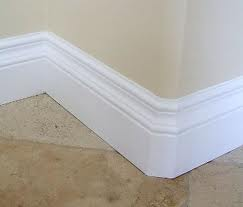Baseboard Installation Has Plenty of Options
 Installing baseboard is an easy job that gives you a lot of bang for the buck. You can go from boring to breathtaking in an afternoon.
Installing baseboard is an easy job that gives you a lot of bang for the buck. You can go from boring to breathtaking in an afternoon.
To change the baseboards and door casings, first remove the old ones without damaging the walls. You can do this by placing a scrap block behind a hammer or pry bar and slowly pry off the old baseboards and casings. Before you pry off the old stuff though, score the top of the baseboards (or side of the casings) with a utility knife, where they met the wall. This will prevent tear-out of the texture and paint where caulking is used to fill the gap.
The cost for new baseboard and door molding varies depending upon type and style. Most trim is made of MDF (medium density fiberboard) covered with a thin veneer. You can also buy trim made from various types of plastic, but I personally don’t like the appearance.
Trim is sold by the linear foot and varies from around .50 cents for the cheap stuff past $6.00 per linear foot for solid wood. You can use a combination of moldings (base shoe, baseboard, base cap) to get custom profiles, but this is up to your taste and budget.
Installing the door casing comes first. Take a pencil and combination square and draw a light line 3/16 of an inch from the edge of the doorjamb. This will be the reveal line, with which the front edge of the trim is aligned. Measure the lengths of the pieces you will need to surround the door and add a little for the mitered corners.
By the way, I would highly recommend that you finish (stain, varnish or paint) the casing and baseboard before you nail it to the wall. It is much easier to stain wood while standing up in your garage that it is to do lying down on your floor.
Once the finish is dry, you will need to miter the corners (cut the corners at 45 degrees). You can cut scrap wood pieces and hold them up to the corners. Although the corners should be a perfect 90 degrees, they often are not. Adjust the saw and cut both pieces at the correct angle.
After the pieces are cut, secure them to the jamb using 4d nails. If you are using hardwood trim, make sure you predrill the holes for the nails. If not, your trim will split and your vocabulary will grow. Sink the head of the nail below the surface of the trim with a nail set and fill the holes with wood putty. You will have to touch up the finish wherever you filled in a nail hole.
Start the baseboards by cutting the length for the longest wall first. If your baseboard won’t completely cover the entire length of the wall, you can splice two pieces together by cutting the adjoining pieces at a 45 degree angle and sliding them together.
There are two ways to get a great looking inside corner. You can miter the corner (as you did with the door casing), or you can cope the inside corner. Coping is cutting the profile of the baseboard into the end of the piece that intersects it.
To cope an inside corner, cut one end at a 45-degree angle, as if you were cutting an inside miter. Then, use a coping saw to cut along the profile left by the miter. You can make a flawless fit by using a wood file to smooth out any rough spots. Continue mitering and/or coping around the room, pre-drill, and nail it up using 6d nails.